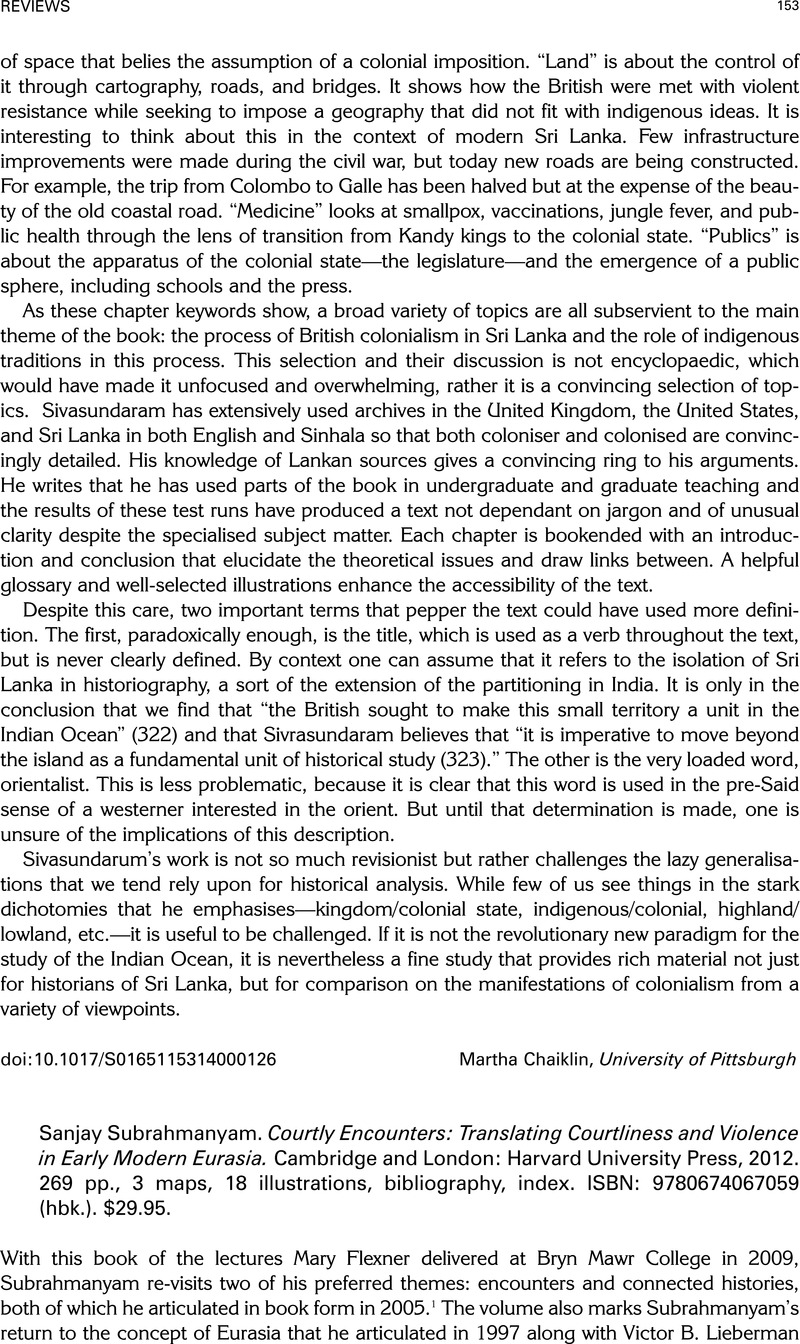No CrossRef data available.
Article contents
Sanjay Subrahmanyam. Courtly Encounters: Translating Courtliness and Violence in Early Modern Eurasia. Cambridge and London: Harvard University Press, 2012. 269 pp., 3 maps, 18 illustrations, bibliography, index. ISBN: 9780674067059 (hbk.). $29.95.
Published online by Cambridge University Press: 01 May 2014
Abstract

- Type
- Reviews
- Information
- Copyright
- Copyright © Research Institute for History, Leiden University 2014
References
Notes
1 Subrahmanyam, S. (2005). Explorations in Connected History. Vol. 1, From the Tagus to the Ganges and Vol. 2, Mughals and Franks. New Delhi: Oxford University PressGoogle Scholar.
2 Lieberman, V (1997). “Introduction.” Modern Asian Studies, 31 (3), 449–61CrossRefGoogle Scholar; Lieberman, V (1997). “Transcending East-West Dichotomies: State and Culture Formation in Six Ostensibly Disparate Areas.” Modern Asian Studies, 31 (3), 463–546CrossRefGoogle Scholar; Subrahmanyam, S. (1997). “Connected Histories: Notes Towards a Reconfiguration of Early Modern Eurasia.” Modern Asian Studies 31 (3), 735–62CrossRefGoogle Scholar. Lieberman, V. (1993). “Local Integration and Eurasian Analogies: Structuring Southeast Asian History, c.1350-c. 1830.” Modern Asian Studies, 27 (3), 475–572CrossRefGoogle Scholar.
3 de Certeau, M. (1988). The Writing of History (Conley, T, trans.) New York: Columbia University PressGoogle Scholar; Weymans, W. (2004). “Michel de Certeau and the Limits of Historical Representation.” History and Theory, 43, 161–78 & 175CrossRefGoogle Scholar.
4 Greenblatt, S. (2005). Renaissance Self-fashioning: From More to Shakespeare. Chicago: University of Chicago PressCrossRefGoogle Scholar; Livieratos, E., & Koussoulakou, A. (2006). Vermeer's maps: a new digital look in an old master's mirror. e-Perimetron, 1 (2), 138–54Google Scholar.
5 Marshall, P. J. (1980). “Western Arms in Maritime Asia in the Early Phases of Expansion.” Modern Asian Studies, 14 (1), 13–28CrossRefGoogle Scholar; Southall, A. (1988). “The Segmentary State in Africa and Asia.” Comparative Studies in Society and History, 30 (1), 52–82CrossRefGoogle Scholar; Hodgson, M. (1974). The Gunpowder Empires and Modern Times. Venture of Islam, Vol. 3. Chicago: University of Chicago PressGoogle Scholar.
6 Gommans, J. (2007). “Warhorse and Post-nomadic Empire in Asia, c. 1000-1800.” Journal of Global History, 2, 1–21CrossRefGoogle Scholar.
7 Laichen, S. (2003). “Military Technology Transfers from Ming China and the Emergence of Northern Mainland Southeast Asia (c. 1390-1527).” Journal of Southeast Asian Studies, 34 (3), 495–517CrossRefGoogle Scholar.
8 Biggs, M. (1999). “Putting the State on the Map: Cartography, Territory, and European State Formation.” Comparative Studies in Society and History, 41 (2), 374–105CrossRefGoogle Scholar.
9 Biggs, M. (1999). “Putting the State on the Map: Cartography, Territory, and European State Formation.” Comparative Studies in Society and History, 41 (2), 399CrossRefGoogle Scholar.
10 Salvadore, M. (2011). “The Ethiopian Age of Exploration: Prester John's Discovery of Europe, 1306-1458.” Journal of World History, 21 (4), 593–627 & 605–6Google Scholar.
11 Beaujard, P (2005). "The Indian Ocean in Eurasian and African World-Systems before the Sixteenth Century. Journal of World History, 16 (4), 411–65 & 440CrossRefGoogle Scholar.




